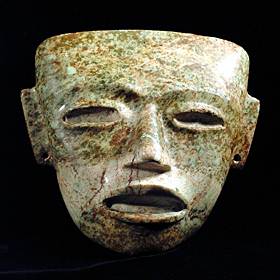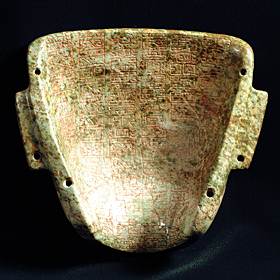
 Photo courtesy Michael Coe (extreme zoom) |
 Photo courtesy Michael Coe (extreme zoom) |
Posted January 11, 2004
|
A Teotihuacan-style mask unearthed from an unknown location in southern Mexico adds some 101 glyphs to the total number currently known for the ancient Isthmian script. Of these, twenty-five are unique additions to the Isthmian corpus, according to Brigham Young University archeologist Stephen Houston and Yale University professor emeritus Michael Coe.
The stone mask, now in a private collection, will be published by Houston and Coe in an upcoming issue of the journal Mexicon, wherein the authors use the mask's incription to demonstrate their contention that the Isthmian script remains undecipherable. The Isthmian script derives its name from the Isthmus of Tehuantepec, the general area from which the known texts orginate. It has also been referred to as "epi-Olmec", based on the belief that it encodes a language descended from that of the Olmec civilization. The best-known Isthmian inscription is carved on a stela recovered from the site of La Mojarra in 1986. In their Mexicon article, Houston and Coe employ the numbers assigned to Isthmian glyphs by Martha Macri and Laura Stark (1993). |
home